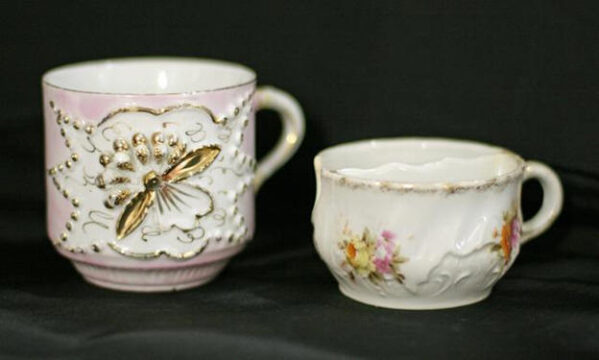
The Rosenberg Library Museum was pleased to display two 19th century mustache cups as the May Treasure of the Month. Beards and mustaches have been distinct characteristics of the male figure throughout history. The oldest known portrait showing a shaved man with a mustache is a Scythian horseman from the Gillette Dynasty, ca. 300 BC. It wasn’t until the Victorian era that the extensive regiment of the mustache wearer necessitated the need for a protective guard. Mustache cups, cups sporting a semi-circular ledge over the rim, were invented to protect the extraordinarily magnificent mustaches of the 19th century from the effects of steam resulting from hot drinks and soups. The artifacts featured during the month of May were donated in 1972 by Mrs. John A. Mowat and in 1987 by Mr. George Beauvais.

The mustache was intensely popular during Victorian times as a rebellious expression of panache from the huge wigs (periwigs) that defined the 18th century. Over the course of the 19th century, the practice of pogonology (the art of facial hair) developed as an art form as many men expressed masculine fashion by cultivating dramatic mustache/beard combinations.
These adorned mustaches were washed, brushed, combed, dyed, and curled by Victorian gentlemen. The necessity to tend to them daily engendered the invention of a wide variety of accoutrements including mustache wax, mustache nets (snoods), mustache brushes, mustache combs, and mustache scissors. For a myriad of reasons, mustaches were grown in all shapes and sizes, and the amount of stiff pomade that was required to hold the hairs in place led to drawing room disasters.
When attending social functions and afternoon teas, two problems arose. Steam from the hot beverages melted the mustache wax and sent it dribbling down the chin, often streaked with dye, right into the cup along with the by then drooping mustache. The other dilemma was that strong coffees and teas often stained and discolored the bottoms of many mustaches.
It wasn’t until 1830 that an English potter named Harvey Adams (maker’s mark ‘HA & Co.’) introduced the first mustache cup. The cup had a ledge called a “mustache guard” that stretched across the inside of the cup from rim to rim. The guard had one semicircular opening against the rim of the cup to allow the user’s mustache to rest safely on the mustache guard. The invention of the mustache cup spread over Europe until most potters featured a product with a similar design. Between the years 1850 – 1900, famous manufacturers such as Meissen, Royal Crown Derby, Imari, Royal Bayreuth, Limoges and others created their own versions of this masculine tableware.
Mustache cups were made from earthenware, porcelain, stoneware, tin and silver plates and came in many shapes and sizes, ranging from tiny demitasse cups to large farmer’s cups holding up to a quart of liquid. Potters created mustache cups which featured landscapes, hunting scenes, animals and birds, flowers, and interesting geometric designs. Portrait mustache cups were rare and highly desirable. Many mustache cups, especially those made in Germany, had luster grounds, which were Victorian favorites.

During the early years of production, mustache cups and saucers were sold as individual items, often ordered by women as gifts for their fathers, brothers, or husbands. Soon, Wedding Sets followed and were engraved “Husband” and Wife” with the cup for the wife matching the husband’s cup in every way except the mustache guard. These matching sets were usually displayed rather than used. As the 19th century progressed, they were sold as part of complete sets of tableware.
Mustache cups became popular in the United States during the mid 19th century. Although many mustache cups were made in America, it is extremely difficult to find a true Victorian mustache cup bearing an American pottery mark. These earliest pieces were marked with names that led one to believe they were manufactured in England due to the popularity of English-made ceramics. Left-handed mustache cups were extremely rare. They were supposedly made-to-order for wives and sweethearts to give to the men returning from the Civil War who had lost the use of their right arms in battle.
During the 1890s, mustache cups reached their peak of greatness. Around 1920 – 1930, masculine mustaches were no longer in vogue and mustache cup production trickled to a halt. Even though there have been smaller waves of popularity, today’s fashions have seen a revival in the creativity of the mustache. Mustache growing competitions now take place around the world. These events and competitions have created a new demand for the 19th century accessory with modern mustache cups being produced by specialty artisans. The Beard Team USA National Beard and Moustache Championships took place in June 2010 in Bend, Oregon.